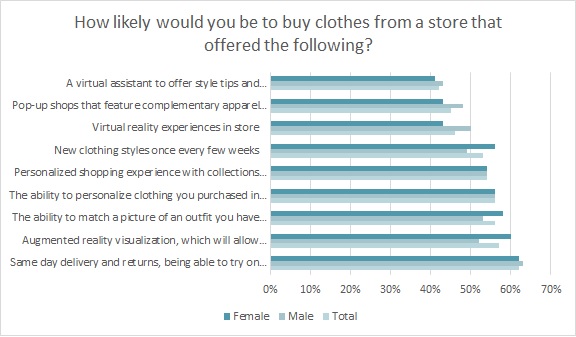When it comes to buying new clothes, most consumers still want to make their purchase in an actual store. But online shopping has made some things so easy that people now view some traditional aspects of in-store shopping — like the fitting room and checking out — as pain points. But retailers are looking to make the job easier, courtesy of some high-tech help.[quote]
When the ecommerce intimates brand Adore Me was looking to open brick and mortar locations, the company saw both opportunity and the potential for friction. At the recent National Retail Federation’s NRF Big Show in New York, Camille Kress, director of retail, said Adore Me was interested in creating a comfortable environment for women, because trying on intimates is often a very uncomfortable experience.
“Usually, one of the reasons is the fitting room itself, where there could be a curtain that doesn’t really close,” Kress said. “Or the sales associates are not there to bring you another size. So that’s really the center point of our how we thought about the experience. We wanted to make it as easy as possible for the customer.”
Enter StoreAdvise, a tech company that developed a platform that would assist and engage the customer in the fitting room, and also help the retailer on a couple of different levels. It all starts with a touchscreen in the fitting room that reads what a customer is bringing in through RFID (radio frequency identification) sensors on each apparel item. The screen automatically makes recommendations for other items and shows additional colors and sizes that are available. Using the screen, the consumer can notify an associate that she would like another garment brought to her. Through the affiliated app, the associate receives a notification on their mobile device, is able to quickly determine what’s in stock and respond.
Most consumers (52 percent) are likely to buy clothes from a store that offers high-tech dressing rooms with features such as a mirror that allows shoppers to see an outfit in various colors, post a picture of themselves in an ensemble to social media and get product details at the click of a button, according to the Cotton Incorporated Lifestyle Monitor™ Survey.

StoreAdvise doesn’t use a “magic mirror,” but rather a high-tech screen within the Adore Me fitting room.
“We’re leveraging RFID technology on inventory, providing a better engagement for Adore Me consumers, and enabling the retail sales associates and manager to provide a better service,” said StoreAdvise’s Keith Sherry, CEO.
Fashion retailers are aware that today’s consumers are used to getting what they want with the tap of a screen. However, most shoppers (72 percent) still prefer to buy their apparel in-store, according to the Monitor™ research. So combining the best of online and brick and mortar shopping is to a retailer’s advantage.
It also makes sense that apparel stores would want to make the fitting room experience more gratifying. Among those who prefer to buy clothes in a physical store, the majority (69 percent) say they do so because they want to try on the garments, according to the Monitor™ research. This is followed by a desire to make sure clothes fit (68 percent), see the item in person (64 percent) and feel the fabric (54 percent). Just 23 percent say they like the shopping experience. And only 9 percent cite customer service.
Consumers who prefer to purchase apparel online do so because it is convenient (66 percent) and easier (53 percent), followed by “better selection” (49 percent) and avoiding crowds (46 percent), according to Monitor™ data.
Adore Me has two stores and implemented the RFID program in both locations. The StoreAdvise program also measures traffic into the fitting rooms, which items were purchased and which went back to the floor, right down to the size and color. Dan Natale, vice president of customer engagement for StoreAdvise, says the program also measures peak fitting room times and tells retailers if they should reallocate associates’ shifts around fitting room activity.
Sherry said his company’s analytics are not just providing information for users.
“We’re trying to move them along this journey from trying to understand loads of data with their generic analytics, and trying to make it prescriptive analytics,” he said.
Retailers and brands can also take advantage of a new product from Wiliot, a semiconductor company. The firm was showing NRF attendees a tiny, battery-free Bluetooth sensor tag that is powered by the energy from stray Bluetooth, WiFi, and cellular frequencies. The device can be placed on plastic or paper tags smaller than a fingernail and thinner than paper. The chips haven’t been commercialized yet, but the idea is that they can be used in applications ranging from manufacturing to retail through to the consumer. For instance, the chip could be used to help companies track product throughout its sourcing journey. It could also track lost or stolen merchandise. And it could enable brands and merchants to conduct continuous inventory.
“We can also measure movement,” said Steve Statler, senior vice president of marketing and business development for Wiliot. “We can tell if the blouse or suit has been picked up off the hanger. This can also tell if an item has been brought into the fitting room and put back on the shelf or purchased.”
“And if consumers are a fan of the brand, they might want to keep track of all their apparel from that brand, so they can opt in to interact,” Statler continued, outlining the possibilities for the device. “Brands could also tell how often you wear an item and offer new recommendations based on that.”
More than half of all consumers (54 percent) would be likely to buy clothes from a store that offered a personalized shopping experience with collections pulled together based on previous purchases and preferences, according to Monitor™ research. Another 42 percent would buy from a store that has a virtual assistant that offers style tips and recommendations based on customer needs.
“We’re also doing a project with an appliance manufacturer that has machines that are enabled with Bluetooth radio and WiFi,” Statler said. “So we have the opportunity to have a washing machine that could stop you from turning your whites pink because it can tell if you’re mixing colors. All of this is not going to happen overnight, but we see the potential.”
Avery Dennison is one of the financial backers of Wiliot’s chip.
“That seamless connectivity at the end-to-end perspective is really the reason why we became very attracted to this,” said Avery Dennison’s Francisco Melo, vice president and general manager, global RFID. “It really opens that possibility of connectivity between the brand and the consumer. If it’s well done, it’s going to provide value to both, which is the ultimate goal.”
